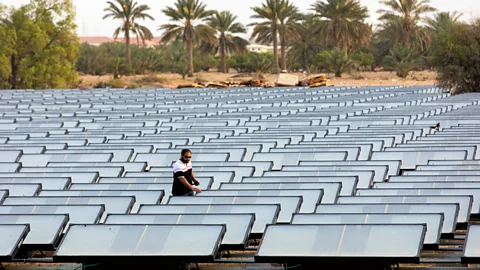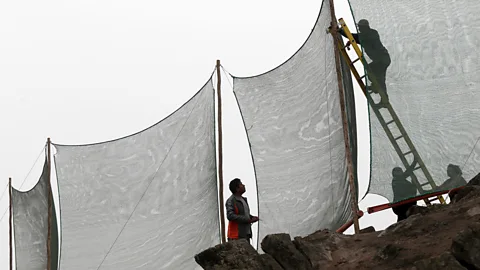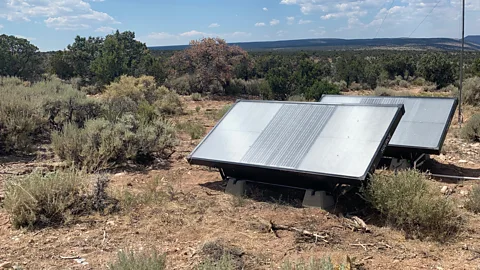How our drinking water could come from thin air
 Getty Images
Getty ImagesFrom solar panels that produce water to 'self-filling' coffee machines and water coolers, technology companies are putting a new spin on a centuries-old technique.
In the dry, desert air of Las Vegas, it seems strange to be talking about a plentiful source of water all around us.
Southern Nevada is in the grip of one of the worst droughts it has experienced in recorded history, leading to water shortages and restrictions on use. So, in water-stressed areas such as this, the prospect of wringing water from thin air is an appealing prospect. And it is exactly what Cody Friesen is trying to do.
Friesen, an associate professor of materials science at Arizona State University, has developed a solar-powered hydropanel that can absorb water vapour at high volumes when exposed to sunlight.
It is a modern-day twist on an approach been used for centuries to pull water from the atmosphere, such as using trees or nets to "catch" fog in Peru, a practice that dates back to the 1500s and is still being used today.
Amid the flashy transparent televisions and electric vehicles at the Consumer Electronics Show (CES) in Las Vegas in January, there were a few start-ups claiming to have new ways of exploiting this ancient, and often overlooked source of clean drinking water. And with the help of artificial intelligence, they're finding ways of pulling even more water out of the air.
 Getty Images
Getty ImagesFriesen founded his own company Zero Mass Water in 2014 following his research on solar-powered hydropanels. Today the company is called Source Global, operates in more than 50 countries and has a private valuation of more than $1bn (£800m).
Sign up for Tech Decoded
For more technology news and insights, sign up to our Tech Decoded newsletter. The twice-weekly email decodes the biggest developments in global technology, with analysis from BBC correspondents around the world. Sign up for free here.
The panels work by using sunlight to power fans that pull air into the device, which contains a desiccant material which absorbs and traps moisture. The water molecules accumulate and are emitted as water vapour as the solar energy raises the temperature of the panel to create a high-humidity gas. This then condenses into a liquid before minerals are added to make it drinkable.
"That's how we're able to create water in most places in the world, even when it's very dry," says Friesen. "We're headquartered in Scottsdale, Arizona, which is sub-5% relative humidity in the summer and we're still making water. It's a uniquely efficient and low-cost approach that enables us to go places where nobody else can go."
The air, even in relatively dry climates, can hold a surprising amount of water. The Earth's atmosphere as a whole contains about six times as much water as the planet's rivers.
Friesen's goal is to democratise access to water for people with few options, such as rural and tribal communities that don't have electricity, and regions devastated by natural disasters. Among Source's customers is a sub-Saharan school in Africa where girls once had to trek for hours a day to find fresh water, and now can spend their time learning instead.
You might also like:
A panel costs about $2,000 (£1,500) and lasts at least 15 years, according to Friesen. But advancements in artificial intelligence have taken yields to the next level with constant monitoring of data in terms of changing conditions, humidity, temperatures, sunlight and usage to extract the maximum amount of water, says Adam Sharkawy of Material Impact, a venture capital company that has invested in Source Global.
"These panels are constructed to create four to five litres of drink per panel per day," he says. "But with AI and machine learning algorithms, these numbers can go much higher, maybe aspiring towards seven, eight, nine. That makes it even more effective and more cost efficient." Yield however is highly-dependent on weather patterns and sun exposure, caveated Source.
 Source Global
Source GlobalFriesen believes his hydropanels could even make drinking water one day available on Mars where the atmosphere averages 1% water vapour. "You'd have to engineer it differently, but there is no reason why you couldn't take that water vapor, absorb it into a material that would be appropriate for that atmosphere, and then use the power of the Sun to respire that water vapour and produce liquid water," he says.
Coffee wizardry
There are some who are looking to use similar techniques to appeal to a very different market. Water dispenser company Kara Water made a splash at CES winning an innovation award last year with a $4,899 (£3,800) designer water cooler they say produces up to 10 litres of water a day by using desiccants to pull moisture from the air.
In 2024, the start-up introduced the Kara Pod, a coffee machine they claim can brew a bottomless cup by continuously refilling itself with water extracted from the air.
Source Global and Kara Water are not alone in their pursuit of air-to-water solutions. In other parts of the world, considerable competition is brewing. Canadian company Rainmaker is marketing products that can harvest up to 20,000 litres per unit per day. Austria's Phantor–Imhotep Industries says it can get 10,000 litres a day. Atmospheric Water Solutions has an air-to-water dispenser that is also an air purifier and dehumidifier. Atmospark is even marketing a mobile device for water-on-the-go, while rivals Watergen have their own device coming soon.
It's too early to say whether these devices will live up to their promise, but the prospect of a truly bottomless cup is hard not to find appealing.
--
If you liked this story, sign up for The Essential List newsletter – a handpicked selection of features, videos and can't-miss news delivered to your inbox every Friday.
